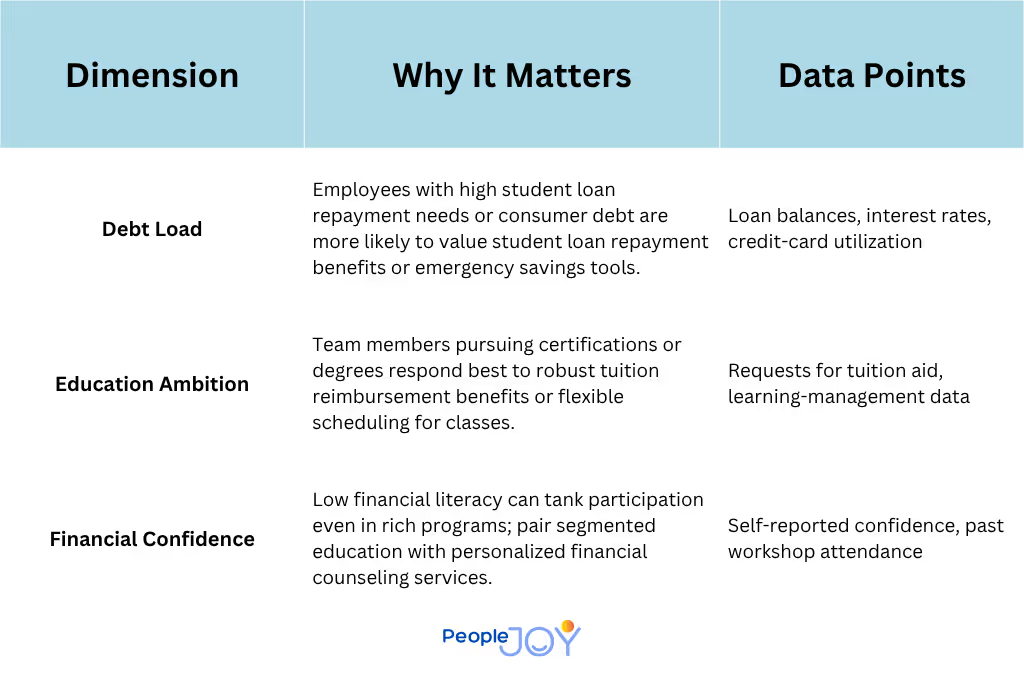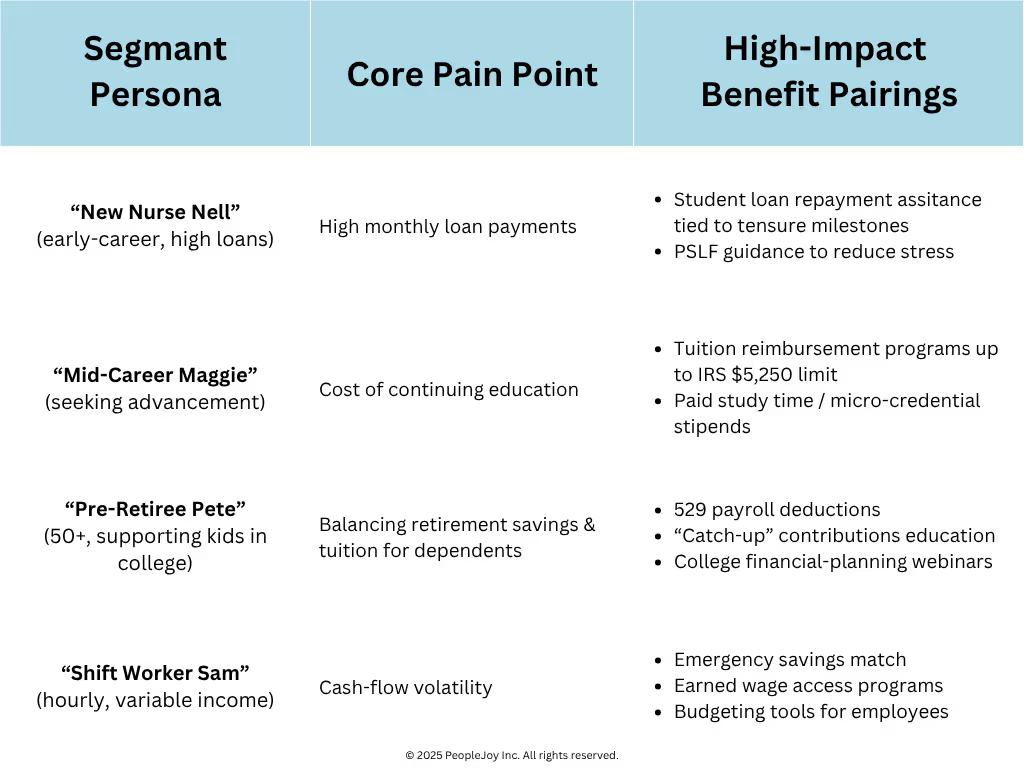A 3-Step Framework for Segmenting Financial Wellness Needs—and Winning Over Your Workforce
Heads of Rewards & Benefits are under intensifying pressure to improve employee retention while keeping benefit budgets in check. Traditional “one-size-fits-all” programs―even well-intentioned employee financial wellness programs―often fall flat because they ignore the wildly different money challenges employees face at various life and career stages. The solution is targeted segmentation: grouping employees by financial wellness needs and matching each group with the benefits to offer employees that will move the needle on engagement and workforce retention.
Below is a practical 3-step framework you can take straight to your next leadership meeting.
Diagnose: Map the Money Moments That Matter
Every organization—whether a multistate hospital network struggling with healthcare employee retention or a fast-growing tech firm—has key “money moments” that drive benefit usage. Use a short, confidential pulse survey (or anonymized payroll data) to uncover three critical dimensions:

Pro Tip: When surveying, sprinkle in language that resonates—terms like “financial wellbeing,” “debt management assistance,” and “retirement planning support.” These keywords signal empathy and boost response rates.
Design: Align Benefits to Each Segment
With solid personas in hand, curate a benefits mix that feels personalized yet remains administratively scalable.

Deliver: Communicate, Activate, Measure
Even perfectly matched benefits under-perform without thoughtful rollout. Apply this three-layer activation plan:
Personalized Communication
- Use AI or rules-based logic to trigger emails using language tuned to each persona—e.g., “Nell, see how an extra $100 per month from our student loan assistance program accelerates your payoff date.”
Moments-That-Matter Nudges
- Send targeted reminders during annual enrollment, work anniversaries, or when a loan servicer change occurs—capitalizing on peak attention windows.
ROI Dashboard
- Track utilization, turnover, and engagement by segment. Heads of Rewards & Benefits can then show how financial wellness benefits for employees directly influence employee retention strategies and cost per hire.
Quick Win: Showcase early success stories in internal newsletters—“Since launch, nurses using our loan coaching saw a 30% drop in financial-stress scores.” Nothing accelerates adoption like peer proof.
Why Segmentation Delivers Board-Level ROI
- Reduced Turnover: Tailored student loan repayment assistance can cut nurse turnover—estimated by NSI at $40K+ per RN—by double-digit percentages.
- Upskilled Workforce: Employees leveraging tuition reimbursement are 21% more likely to earn promotions, shrinking external recruiting spend.
- Higher Engagement Scores: Organizations that invest in employee financial wellness see up to a 5-point boost in Gallup Q12 engagement metrics.
When you translate these outcomes into hard dollars, segmentation quickly moves from “nice to have” to C-suite imperative.
Final Takeaway for Rewards & Benefits Leaders
Segmentation is the bridge between costly, under-utilized perks and a laser-focused portfolio of financial wellness employee benefits that employees actually love. Start by diagnosing real needs, design benefit bundles that map to those needs, and deliver through data-rich, personalized communication. Your reward? A more resilient, financially confident workforce—and a bulletproof business case that even the CFO will applaud.
Ready to put segmentation to work for your organization? Book a 15-minute strategy call with PeopleJoy to see how our platform helps HR teams reduce hospital staff turnover, boost work-life balance in healthcare settings, and drive measurable workforce retention—all while delighting employees at every life stage.
%20From%20Generic%20to%20Strategic%20-%20How%20Segmenting%20Financial%20Wellness%20Drives%20Retention%20in%20Healthcare.avif)
%20Guiding%20Borrowers%20to%20Hope_%20Shanna%E2%80%99s%20%E2%80%9CWhy%E2%80%9D%20at%20PeopleJoy.avif)
%20(M)%20%E2%80%9CI%20Submitted%20My%20IDR%20Form%20Months%20Ago%E2%80%94Where%E2%80%99s%20My%20Update.avif)



